Vehicle safety is key, and the Anti Lock Braking System (ABS) is a major player. It helps control the vehicle and cuts stopping times by up to 30% on slippery roads. ABS stops wheels from locking up, keeping the vehicle stable and under control.
ABS is vital for preventing accidents. It lets drivers steer while braking, even on slippery roads. This is critical because locked wheels can cause loss of control and longer stops. With ABS, drivers can steer and brake safely, reducing the risk of accidents.

ABS is a cornerstone of modern vehicle safety. It’s a must-have in today’s cars, thanks to a 2011 federal rule. ABS enhances control and reduces stopping times, making it essential for safe driving.
Key Takeaways
- ABS improves vehicle control and decreases stopping distances by up to 30% on slippery surfaces.
- ABS is a standard feature in most new vehicles, required by the federal government as of September 1, 2011.
- ABS enables drivers to maintain control of their vehicle, even in emergency braking situations.
- ABS is essential on slippery surfaces, preventing loss of control and long stops.
- ABS is a key part of braking technology, boosting overall vehicle safety.
Understanding Anti Lock Braking System ABS Fundamentals
The Anti Lock Braking System (ABS) is key in modern cars. It helps keep the vehicle safe and in control when you need to stop fast. ABS stops the wheels from locking up, which keeps them from slipping on the road.
ABS uses electronic and computer controls to act faster than old braking systems. It checks each wheel’s speed and adjusts the brakes to keep the car stable.
Basic Principles of ABS Operation
ABS makes it less likely for wheels to lock up and skid, which is safer. It works by quickly pressing the brakes a few times a second. This keeps the car stable when you need to stop suddenly.
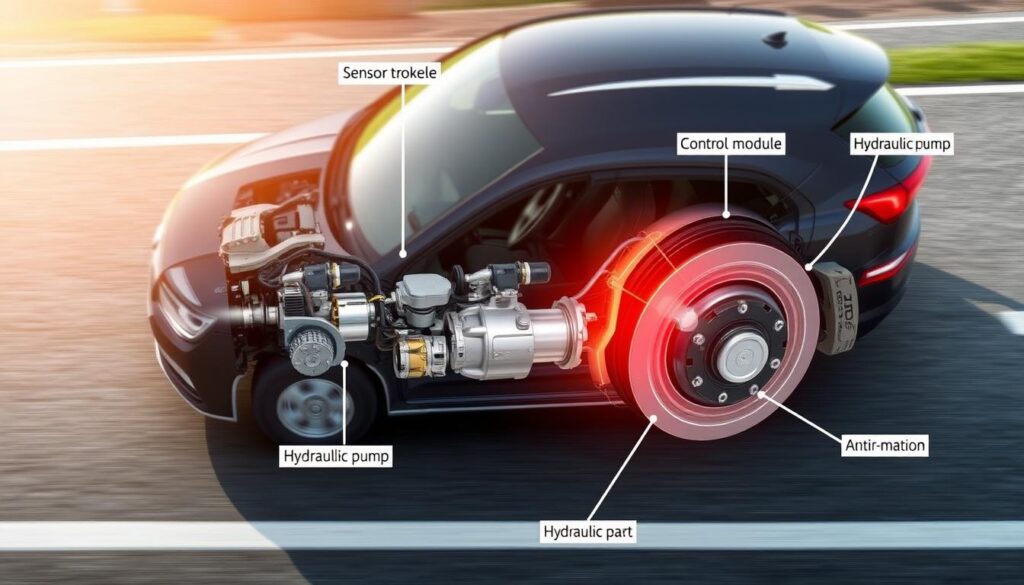
Key Components of an ABS System
An ABS system has a few main parts. These are wheel speed sensors, hydraulic valves, and the electronic control unit (ECU). Together, they watch the wheel speed, change the brake pressure, and stop wheels from locking up.
How ABS Prevents Wheel Lock-up
ABS stops wheels from locking up by quickly pressing the brakes. This lets the driver keep control of the car when stopping fast. It’s very helpful on wet or slippery roads, where old brakes might cause wheels to lock up.
The Evolution of Braking Technology
The journey of braking technology has been long and filled with important steps. A big leap forward was the creation of Anti-lock Braking Systems (ABS). Starting September 1, 2011, all new cars must have ABS. This shows how vital it is in keeping drivers safe.
ABS has some key parts:
- Speed sensors on all wheels to prevent wheel lock-up during braking
- Electronic control unit (ECU) to process data and control the braking system
- Valves and a pump to apply and release the brakes
Studies show cars with ABS have fewer accidents than those without. ABS helps drivers avoid the need for manual braking in emergencies. This makes driving safer, even for less experienced drivers.
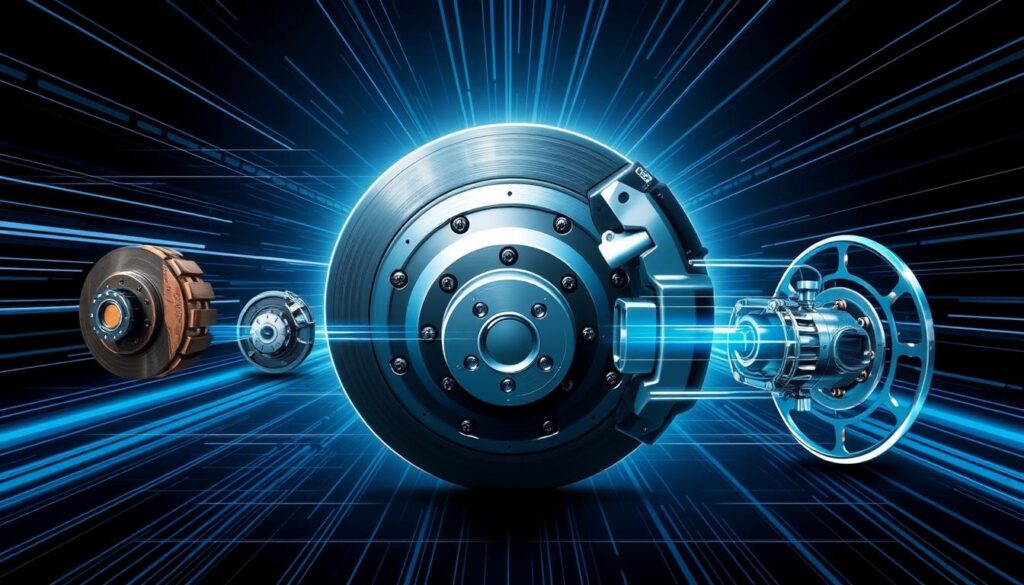
In summary, braking technology has greatly improved vehicle safety. With ABS getting better, we can look forward to even safer cars. These advancements will help save lives and reduce accidents.
How Anti Lock Braking Systems Work in Modern Vehicles
Anti-lock braking systems (ABS) are key in keeping vehicles safe. They stop wheels from locking up when you brake hard. This is thanks to sensors that watch wheel speed and alert the system to act fast.
The system uses sensors to check each wheel’s speed. If a wheel is about to lock, the sensor alerts the ECU. The ECU then quickly pumps the brakes to keep control, even on slippery roads.
Sensor Operations and Detection
Sensors are the heart of ABS. They watch each wheel’s speed and send data to the ECU. This helps the system catch lock-up before it happens.
Electronic Control Unit Processing
The ECU is the brain of ABS. It takes sensor data and controls the brakes. It uses smart algorithms to keep the vehicle stable and in control.
Hydraulic System Response
The hydraulic system does the work of braking. The ECU tells it when to apply and release the brakes. This quick action helps the driver stay in control, even in emergencies.
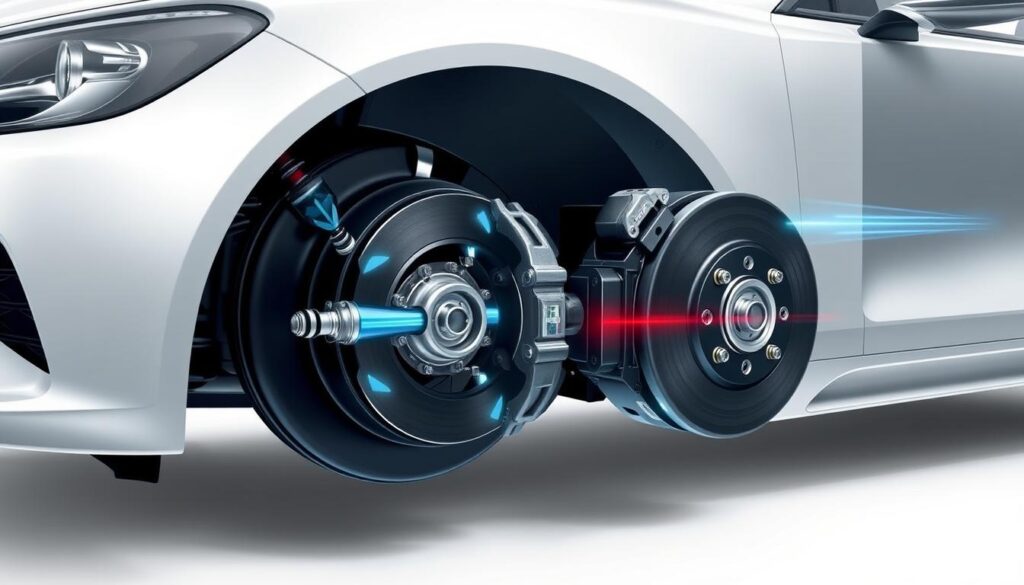
- A typical vehicle may take about five seconds to stop from 60 mph under ideal conditions.
- ABS systems can shorten stopping distances by 10-30% on slippery surfaces compared to non-ABS systems.
- ABS-equipped vehicles have a 30% lower risk of being involved in accidents compared to those without it.
Core Benefits of ABS in Vehicle Safety
ABS in vehicles offers many safety benefits. It stops wheels from locking up and cuts down on stopping times. This helps prevent accidents and lowers the chance of injury or death. Key ABS benefits include:
- Improved vehicle control, even on slippery roads
- Shorter stopping distances, helping avoid rear-end crashes
- Less chance of skidding and losing control, key in emergency stops
- Lower risk of rollover crashes, which can be very dangerous
The National Highway Traffic Safety Administration (NHTSA) says ABS cuts fatal crashes by about 20%. Also, cars with ABS might see insurance costs drop by up to 10%.

ABS is a must-have in today’s cars. It boosts control, cuts down on stopping times, and lowers accident risks. ABS can cut skidding and losing control risks by 30-60% compared to cars without it. This makes ABS a key part of keeping drivers safe.
| Benefit | Description |
|---|---|
| Improved vehicle control | ABS prevents wheel lock-up, reducing skidding and losing control risks |
| Reduced stopping distances | ABS can cut stopping times by 10-20% on slippery roads |
| Decreased risk of accidents | ABS lowers fatal crash risks by about 20% and rear-end crashes by around 35% |
Different Types of Anti Lock Braking Systems
There are many types of ABS for various vehicles. They aim to stop wheels from locking up during hard braking. This helps keep the vehicle stable and in control.
Braking systems are key to keeping vehicles safe. ABS systems come in two main types: two-wheel and four-wheel. Two-wheel ABS is often seen on light trucks and vans, mainly on the rear wheels. Four-wheel ABS is common in most cars and light trucks.
Four-Channel, Four-Sensor Systems
These systems are the most advanced. They control each wheel individually. They are found in high-performance vehicles, providing better stability and control.
Three-Channel Systems
These systems are used in lighter vehicles. They balance performance and cost. They control the front wheels separately and the rear wheels together.
Single-Channel Systems
These are the simplest systems. They control all four wheels together. They are used in older vehicles or those with basic braking systems.

In conclusion, knowing about the different types of ABS and braking systems is vital. It shows how complex and important vehicle safety features are.
ABS Integration with Other Safety Features
ABS integration with other safety features is key for better vehicle safety. It combines ABS with traction control and electronic stability control. This makes a strong safety system. It helps vehicles stay stable and in control, even when driving is tough.
Some important safety features that work with ABS include:
- Traction control, which stops wheel spin and keeps traction
- Electronic stability control, which keeps the vehicle on course and prevents skidding
- Emergency brake assist, which adds extra braking power in emergencies
ABS working with these features greatly lowers accident risk. Studies have shown that cars with ABS and other safety features have fewer accidents and injuries. The ABS module uses wheel speed sensor info to stop wheels from locking up. This keeps the vehicle stable when braking.

In summary, ABS working with other safety features is vital for vehicle safety. It helps vehicles stay stable and in control, even in tough driving conditions. This reduces accident risk and boosts overall safety.
Common Signs of ABS Malfunction
ABS malfunction can be a serious issue, affecting your vehicle’s safety and performance. One common sign is the ABS light on your dashboard. This light can turn on for many reasons, like low brake fluid, faulty sensors, or a bad ABS module.
Other signs include unusual brake pedal behavior and strange sounds when braking. These can mean problems like worn-out brake pads or faulty sensors.
Some common issues related to ABS malfunction include:
- Warning light indicators: The ABS light can illuminate due to low brake fluid levels, malfunctioning wheel speed sensors, or a faulty ABS module.
- Unusual brake pedal behavior: A spongy or hard brake pedal can be a sign of ABS malfunction.
- Strange sounds during braking: Clicking or grinding noises can indicate a problem with the ABS system.

Regular diagnostics and maintenance can help find and fix ABS problems early. If you notice any of these signs, get your vehicle checked by a professional mechanic. This ensures your safety on the road.
| Common Signs of ABS Malfunction | Description |
|---|---|
| ABS light illumination | Can be caused by low brake fluid levels, malfunctioning wheel speed sensors, or a faulty ABS module |
| Unusual brake pedal behavior | Can be a sign of worn-out brake pads, faulty ABS sensors, or other issues |
| Strange sounds during braking | Can indicate a problem with the ABS system, such as a faulty sensor or worn-out brake pads |
Maintaining Your Vehicle’s ABS
Regular ABS maintenance is key to your vehicle’s Anti-lock Braking System working well. This means keeping tires inflated right, replacing brake pads, and checking the system often. These steps help avoid problems and keep you safe while driving.
Some important maintenance tasks include:
- Regular brake inspections, recommended at least once a year
- Proper tire inflation to prevent uneven wear and improve braking performance
- Brake pad replacement to prevent wear and tear on the braking system
Also, gentle braking and avoiding harsh acceleration can make ABS parts last longer. If you see ABS warning lights, fix the issue fast. Ignoring them can increase the chance of brake failure.
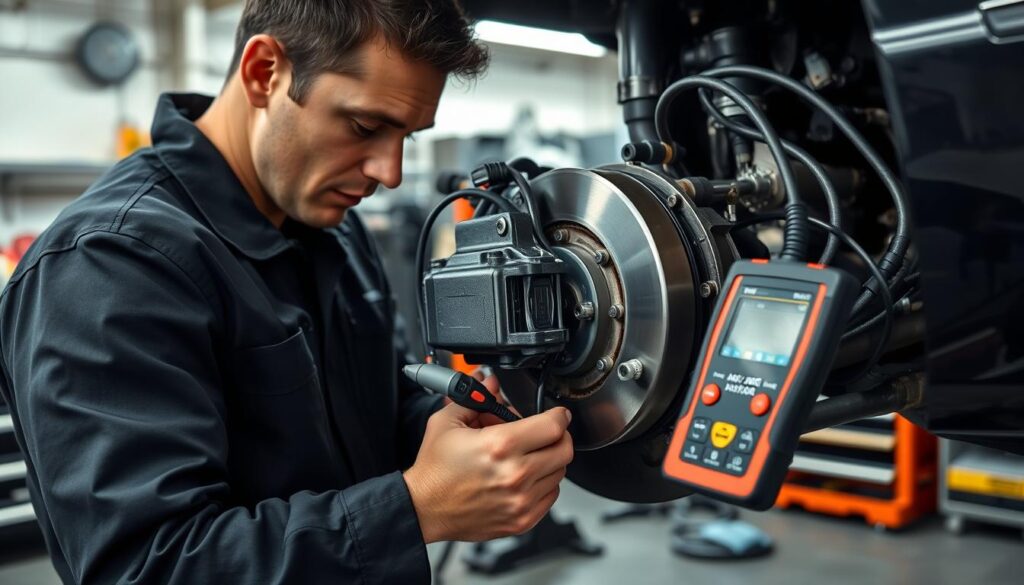
By focusing on vehicle maintenance and following these tips, you keep your ABS in top shape. Regular care is essential to avoid problems and keep your vehicle running well.
| Maintenance Task | Recommended Frequency |
|---|---|
| Brake inspections | At least once a year |
| Tire inflation checks | Monthly |
| Brake pad replacement | As needed |
ABS Performance in Different Weather Conditions
ABS performance is key in all kinds of weather. It greatly affects vehicle safety. On wet roads, ABS can cut stopping times by 20-30% compared to old braking systems. This is because ABS stops wheels from locking up, keeping the car stable and in control.
In snowy or icy weather, the chance of wheels locking up is higher. ABS is essential for keeping control. Research shows ABS cars have 30% fewer accidents in bad weather than non-ABS cars. Also, ABS can cut the chance of losing control in snow or ice by about 40%.
The following table summarizes the benefits of ABS in different weather conditions:
| Weather Condition | ABS Benefit |
|---|---|
| Wet Roads | Decreased stopping distances by up to 20-30% |
| Snowy or Icy Conditions | Reduced risk of losing vehicle control by approximately 40% |
| Dry Roads | Minimally improved stopping distances, but benefits in emergency braking situations |

The Role of ABS in Emergency Situations
In emergency situations, ABS is key to vehicle safety. It stops wheels from locking up and keeps the vehicle under control. This can prevent accidents and lower the chance of injury or death. The National Highway Traffic Safety Administration (NHTSA) made ABS mandatory in all new cars starting September 1st, 2011.
ABS helps a lot, even on dry roads. But it’s most useful on wet or slippery surfaces. A 2009 NHTSA study showed ABS cuts down on crashes. It also lets drivers steer while braking hard, which is vital for avoiding things.
Some main advantages of ABS in emergencies are:
- Less stopping distance on dry roads
- Better control on wet or slippery roads
- Less chance of wheel lock-up and skidding
- More control over steering during hard braking
ABS is a vital part of vehicle safety, mainly in ABS emergency situations. Knowing how ABS works and its benefits helps drivers see its importance. It helps prevent accidents and saves lives.

| Vehicle Type | Reduction in Crash-Involvement Rate |
|---|---|
| Passenger Cars | 6% |
| Light Trucks | 8% |
ABS vs Traditional Braking Systems
ABS and traditional braking systems have their own pros and cons. ABS stops the brakes from locking up during hard stops. This helps keep the vehicle in control. Traditional brakes can cause loss of control and longer stopping times.
Research shows ABS cuts braking distance by 10-30% on slippery roads. It also helps drivers keep the vehicle straight during emergency stops.
The key differences between ABS and traditional brakes are listed in the table below:
| Braking System | Stopping Distance | Steering Control |
|---|---|---|
| ABS | Reduced by 10-30% on slippery surfaces | Enhanced steering control during braking |
| Traditional | Increased stopping distance on slippery surfaces | Potential loss of steering control during braking |
In summary, ABS and traditional brakes have their own benefits and drawbacks. ABS is better for control and shorter stops. But, some drivers might prefer traditional brakes in off-road or bad weather conditions.
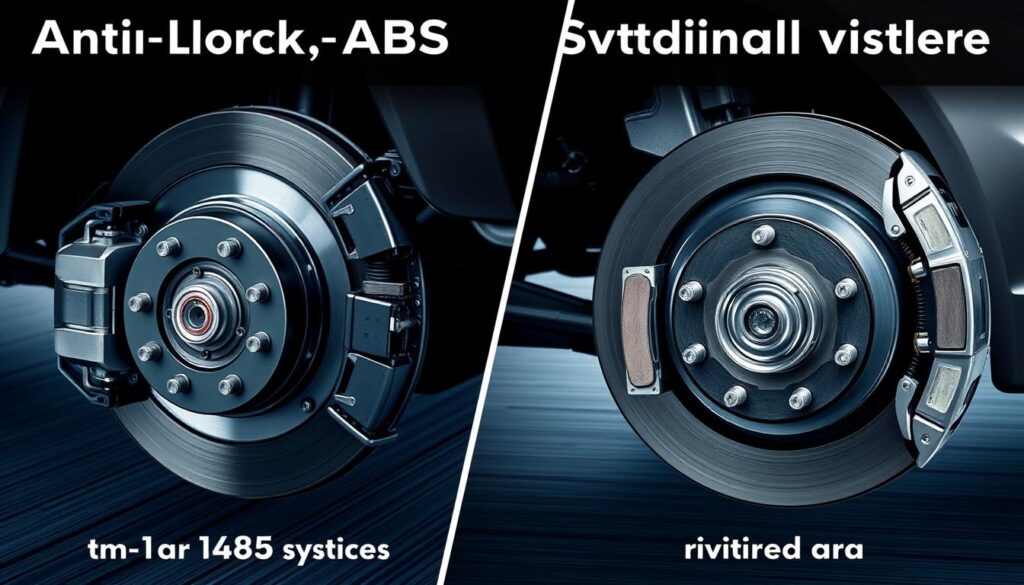
Legal Requirements and Safety Standards
The Anti Lock Braking System (ABS) has greatly improved vehicle safety. Safety standards now require all vehicles to have ABS. In the United States, the Federal Motor Vehicle Safety Standards (FMVSS) make ABS mandatory for trucks and buses made after March 1, 1999.
Some important ABS regulations are:
- Truck tractors made after March 1, 1997, must have an antilock brake system under FMVSS No. 121.
- Commercial motor vehicles (except truck tractors) made after March 1, 1998, need an antilock brake system under FMVSS No. 121.
These rules have lowered accident rates and boosted vehicle safety. ABS is now a common feature in cars. Its role in safety standards has been huge.

The car industry keeps getting better, and ABS regulations and safety standards will get stricter. This will lead to even safer cars. By following these rules, car makers can make sure their vehicles are safe for everyone.
Cost Considerations and Value Analysis
Thinking about getting an Anti-lock Braking System (ABS)? It’s key to look at the cost and do a value analysis. The average price for an ABS system is about $200 to $500 per unit. This price can change based on the car type and who made it.
The cost of an ABS system includes several parts. These are installation costs, upkeep expenses, and the long-term benefits. Important things to think about are:
- Installation expenses: The initial cost of putting in an ABS system. This can differ based on the car and who made it.
- Maintenance costs: The ongoing costs for keeping the ABS system in good shape. This includes brake checks and replacements.
- Long-term value benefits: The long-term savings and better safety that come with an ABS system.
Doing a detailed value analysis helps car owners decide if an ABS system is good for them. It can cut down on stopping times and make driving safer. So, an ABS system can be a smart choice for many drivers.

Future Innovations in ABS Technology
The car industry is on the verge of a big change, with ABS innovation at the forefront. As future technology advances, we’ll see big improvements in anti-lock braking systems (ABS). With over 290 new ideas coming, ABS is set to get much better.
Big names like Hitachi, Toyota, and Honda are putting a lot of money into ABS innovation. They’re working on better sensors and self-driving cars. The ABS market is expected to grow by over 7% each year until 2030. This is because people want safer cars and governments are making rules to help.
Some big changes coming to ABS include:
- Advanced sensor systems for better braking
- Autonomous vehicles with ABS technology
- More ABS in commercial vehicles

As the industry keeps moving forward, future technology will play a bigger part in ABS. With big investments in ABS tech in places like India, Brazil, and South Africa, the global market is set to grow.
| Region | ABS Market Growth |
|---|---|
| Asia-Pacific | Fastest-growing region |
| Europe | Established market with steady growth |
| North America | Mature market with increasing demand for advanced ABS systems |
Common Myths About Anti Lock Braking Systems
There are many safety misconceptions about Anti-lock Braking Systems (ABS). One big myth is that ABS stops your car from sliding on icy roads. But, ABS is made to stop wheels from locking up, not to prevent sliding. It can make your car stop faster, but it can’t stop sliding on slippery roads.
Another myth is that ABS doesn’t work in bad weather. But, cars with ABS are 25% less likely to crash on wet roads. This is because ABS can control brakes much faster than a person can, making it a key safety feature.
Here are some important facts about ABS:
- ABS can cut the risk of accidents by 35% during emergency stops.
- Cars with ABS are 25% less likely to crash on wet roads.
- ABS can control brakes hundreds of times per second, much faster than humans.
It’s important to know how ABS really works to understand its value. By clearing up ABS myths, we can better appreciate this safety feature. This helps us use ABS more effectively in our vehicles.

| ABS Benefits | Description |
|---|---|
| Reduced stopping distance | ABS can reduce the stopping distance significantly, making it an essential safety feature. |
| Improved safety | Vehicles equipped with ABS are 25% less likely to be involved in fatal crashes on wet or slippery roads. |
| Enhanced control | ABS technology can pulse brakes hundreds of times per second, significantly faster than human control. |
Conclusion
The Anti-lock Braking System (ABS) is a key safety feature in today’s cars. It stops wheels from locking up and helps keep control during sudden stops. This has greatly reduced accidents and saved lives.
ABS works best in bad weather like rain, snow, and ice. It helps drivers stay in control and avoid skidding.
ABS technology has come a long way, from aircraft to cars. It now includes features like controlling each wheel and quick brake adjustments. This makes ABS a vital part of modern cars.
Looking ahead, ABS will keep getting better. It will work even better with new autonomous driving features. This means our cars will be safer and more stable than ever.
Drivers can feel safe knowing ABS is always protecting them. It works hard to keep everyone safe on the road.
FAQ
What is the Anti Lock Braking System (ABS) and how does it work?
The Anti Lock Braking System (ABS) is a safety feature in cars. It stops wheels from locking up when you brake hard. ABS keeps the wheels moving by adjusting the brake pressure, so you can steer the car while braking.
What are the key components of an ABS system?
An ABS system has a few main parts. There are wheel speed sensors, a hydraulic modulator, and an electronic control unit (ECU). The sensors watch the wheel speed, the modulator changes brake pressure, and the ECU controls everything for the best braking.
How does ABS prevent wheel lock-up and maintain vehicle control?
ABS stops wheels from locking up by quickly changing brake pressure. It reduces pressure when a wheel is about to lock and increases it when it’s back in traction. This lets you steer the car and avoid skidding during hard braking.
What are the key benefits of ABS in vehicle safety?
ABS has many benefits. It shortens stopping distances, keeps the car stable, and lets you steer during emergency stops. It helps prevent accidents by keeping you in control of the car.
What are the different types of ABS systems available?
There are several ABS systems. Some monitor each wheel, while others watch two front wheels and the rear axle. The type depends on the car’s size and use.
How does ABS integrate with other safety features?
ABS works with other safety tech like traction control and electronic stability control. Together, they improve the car’s stability and stopping power in different conditions.
What are some common signs of ABS malfunction?
Signs of ABS trouble include the ABS light on, a spongy brake pedal, and strange noises when braking. If you notice these, get it checked by a mechanic.
How can I maintain the performance of my vehicle’s ABS?
To keep your ABS working well, check tire pressure, replace brake pads, and follow the manufacturer’s service schedule. Regular maintenance ensures it works right.
How does ABS perform in different weather conditions?
ABS works in various weather, like rain or snow. It helps with braking, but always drive carefully to stay safe.
What role does ABS play in emergency situations?
In emergencies, ABS is key. It prevents wheels from locking up and lets you steer. This is vital for avoiding accidents and keeping you safe.